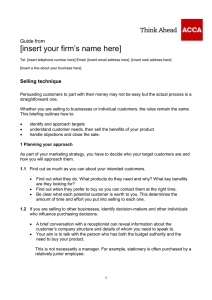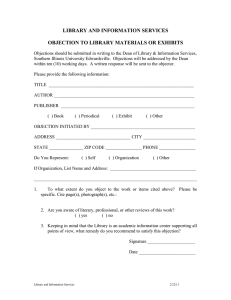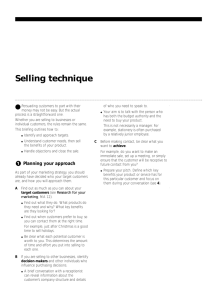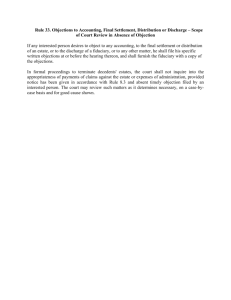Name of ACCA member organisation here Factsheet from
advertisement
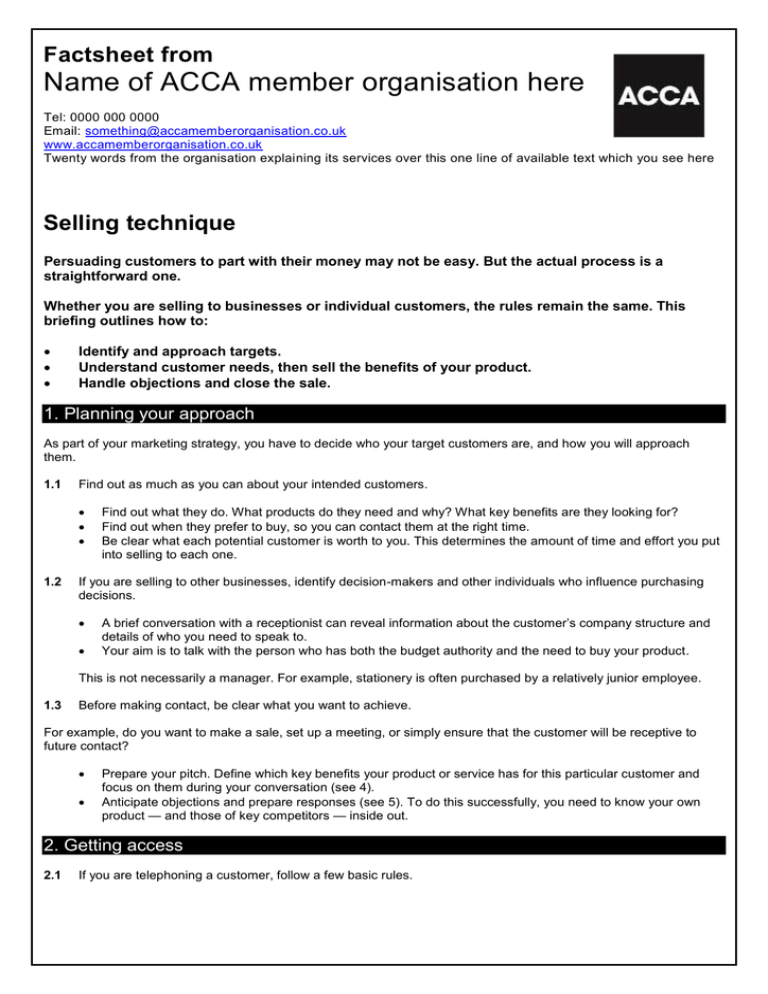
Factsheet from Name of ACCA member organisation here Tel: 0000 000 0000 Email: something@accamemberorganisation.co.uk www.accamemberorganisation.co.uk Twenty words from the organisation explaining its services over this one line of available text which you see here Selling technique Persuading customers to part with their money may not be easy. But the actual process is a straightforward one. Whether you are selling to businesses or individual customers, the rules remain the same. This briefing outlines how to: Identify and approach targets. Understand customer needs, then sell the benefits of your product. Handle objections and close the sale. 1. Planning your approach As part of your marketing strategy, you have to decide who your target customers are, and how you will approach them. 1.1 Find out as much as you can about your intended customers. 1.2 Find out what they do. What products do they need and why? What key benefits are they looking for? Find out when they prefer to buy, so you can contact them at the right time. Be clear what each potential customer is worth to you. This determines the amount of time and effort you put into selling to each one. If you are selling to other businesses, identify decision-makers and other individuals who influence purchasing decisions. A brief conversation with a receptionist can reveal information about the customer’s company structure and details of who you need to speak to. Your aim is to talk with the person who has both the budget authority and the need to buy your product. This is not necessarily a manager. For example, stationery is often purchased by a relatively junior employee. 1.3 Before making contact, be clear what you want to achieve. For example, do you want to make a sale, set up a meeting, or simply ensure that the customer will be receptive to future contact? Prepare your pitch. Define which key benefits your product or service has for this particular customer and focus on them during your conversation (see 4). Anticipate objections and prepare responses (see 5). To do this successfully, you need to know your own product — and those of key competitors — inside out. 2. Getting access 2.1 If you are telephoning a customer, follow a few basic rules. Ring at the right time. People are naturally more responsive to calls in the morning. Get the crucial first 30 seconds of your pitch right. If you fail to prepare your opening carefully, you have little chance of interesting the customer in what you have to offer. 2.2 Get receptionists and assistants on your side. 2.3 Check that you are talking at a convenient time. Be ready to keep your call short. Engage the customer’s interest. 2.5 Be friendly, not pushy. Ask them to help you. Part of a receptionist or assistant’s job is to prevent unwelcome sales calls getting any further. Explain the benefit the customer will get from taking your call or giving you an appointment. Make a note of their name and use it the next time you call. When you make contact with decision-makers, treat them considerately. 2.4 Check you are speaking to the right person. Ask what involvement he or she has in making purchasing decisions. Always get your customer’s name and give your own, too. Introduce yourself and establish the basis for talking. For example, ‘Did you receive my letter?’ or ‘Your friend X suggested I call you’. Briefly outline the key benefit your product has for this particular customer. Ask if the customer is interested in what you have said so far. If the answer is yes, go on to ask more questions (see 3). If not, ask if your product or service might be of interest at a later date. Be prepared to be persistent, particularly if you do not have an existing relationship. If you get an immediate brush-off, try to keep the conversation going. For example, if you are asked to put something in the post, ask what in particular the customer is interested in. If customers say they need to think about it, ask what their concerns are. Stay focused on what you want to achieve. If you want a meeting, ask for one. Suggest a time and a place. Customers prefer, and are less likely to cancel, meetings on their own premises. Use each time you make contact to build your understanding of the customer. Record useful information including details of the customer’s circumstances and needs. For example, about budgets and the names of decision-makers. 3. Asking questions Whether you are selling face-to-face or over the phone, asking questions is essential if you want to understand your customer’s needs. Do not attempt to sell at this point. 3.1 Make the customer want to answer further questions. 3.2 Start with questions to which you know the answer will be yes. For example, ‘Are you interested in reducing your production costs?’ Find out the customer’s situation. Use open questions that cannot be answered with a simple yes or no. For example, ‘How do you plan to reduce your production costs?’ 2 Identify areas your product relates to and needs that it can meet. Try to establish what the customer’s business would be worth to you. Show your understanding of the customer’s field of business. For example, ‘Now that you are getting orders abroad, distribution must be more of a challenge.’ 3.3 Encourage the customer to ask you questions. Listen to the answers carefully and take notes. Check you have understood the customer’s needs by summarising in your own words what has been said. 4. Selling the benefits Once you understand what customers are looking for, you must show the benefits they will get from buying your product or service. 4.1 Sell benefits, not features. Feature: This PC has a processor speed of 3GHz. Benefit: This PC lets you do things twice as fast. Feature: This frying pan has a Teflon coating. Benefit: It's non-stick and easy to clean. Features describe what a product can do. Benefits explain what these features can do for the customer. 4.2 Match the benefits to the customer’s needs. The same product may be sold differently to two different customers, according to their priorities. For example, if you are selling a car, you might stress the benefits of its safety features when selling to parents, while focusing on style and design when selling to a non-parent. 4.3 Stress the knock-on effects your product’s benefits could have. For example, ‘If your accounting software was easier to use, your accounts staff could spend more time chasing debts.’ If customers seem hesitant, ask them what their concerns are (see 5). 5. Handling objections Do not be put off by objections — they can be a sign that the customer is interested. Make sure that you handle them in a direct and positive way. 5.1 Show the customer that you take the objection seriously. Listen carefully to find out what the customer really means. For example, ‘The price is too high’ could mean ‘It’s over my budget sign off’ or ‘I’d buy it if you gave me a discount.’ 5.2 Summarise what you understand the objection to be. Isolate, test and address objections. 3 5.3 If there are several, clarify what each one is before tackling them, one at a time. Test each objection. For example, ask ‘So, if I could satisfy you that delivery would be reliable, would you place an order?’ If an objection is valid, address it and then ask if you have satisfied the customer’s concerns. The most common objection to making a purchase is price. Try to find out exactly what aspect of price the customer is unhappy with before deciding how to respond. Demonstrate the savings your product or service would bring. Sell the full package you offer, including your reliable after-sales service and the fact that there are no hidden costs. Explain how payment terms, credit or financing could make a deal possible. If the individual you are negotiating with does not have budget authority for the level of spending you propose,ask your contact to refer you to someone within the organisation who can authorise the purchase. 6. Closing the deal 6.1 Create a sense of urgency. Try to convince the customer that your product is needed now. Do not falsely state that a product will only be available for a limited time in order to get consumers to buy there and then. This is illegal under the Consumer Protection from Unfair Trading Regulations. Link a quick sale to meeting the customer’s own needs and deadlines. For example, ‘If you book the holiday now, we can get you the best rooms in the hotel.’ 6.2 Look for buying signals from the customer. For example: ‘When would you be able to deliver?’ ‘What other colours do you have?’ ‘That would be really useful.’ ‘This is just what we need.’ Once you have spotted a buying signal, be ready to close the deal. 6.3 Take responsibility for closing the sale. Be positive and upbeat. The simplest way may be just to ask, ‘Can I take your order now?’ Take your cue from the customer. For example, if he or she asks about the price of a product, say ‘So is that the product you would like to buy?’ Propose alternatives. This makes it more difficult for the customer to say no. Ask, ‘Would you prefer it in green or blue?’ When only one objection remains, make closing the sale conditional upon removing this obstacle. For example, ‘If I can guarantee to bring the delivery date forward to meet your schedule, will you place the order now?’ Once you have asked for the sale, stop talking. Your silence encourages the customer to think things through and reach a decision. 6.4 Agree actions and confirm these in writing, including timescales. Confirm that you have understood correctly what the customer wants. 4 Give your customers good after-sales service, so that they will want to buy from you again. 7. Face-to-face 7.1 Prepare for face-to-face meetings. If appropriate, send a proposed agenda and ask if there is anything in particular the customer would like you to cover. Always confirm the time and venue in writing. Do not ring on the day to confirm the meeting is taking place. Given the option, customers often cancel. 7.2 Make sure you arrive in good time. Use effective presentation techniques. Find out about your audience. For example, if you are presenting the benefits of your contact management software to a sales team, you do not need to focus on how easy it is to install. Structure the presentation carefully. In your introduction, tell the audience what the key points of the presentation will be. Deal with these in the main part of the presentation. Then, at the end, summarise again the points you have covered. Keep your audience involved. Never read from a typed script. Use appropriate visual aids. If your audience seem bored or distracted, invite questions to get their interest back. 7.3 A face-to-face meeting is your best opportunity to build a lasting rapport with the customer. Be interested. Encourage customers to talk and ask questions about things that concern them. Show interest in the customer as a person. Remember personal information about family and out-of-office interests. Adapt to the character of the customer. Make your style positive and confident, and discuss your product or service with enthusiasm. Close the deal. 8. Legal obligations Businesses in all sectors are banned from using unfair commercial practices to market and sell to consumers. There are also additional protections for consumers who make purchases from a trader who is making a visit to their home or place of work. Firms are also banned from advertising in a way that misleads other traders. 8.1 Consumer Protection from Unfair Trading Regulations. 8.2 Commercial practices are deemed unfair if they mislead (by action or omission) or are aggressive (by intimidating or exploiting consumers). The regulations have banned 31 aggressive and misleading sales practices including: falsely stating that a product will be available for a very limited time only; exaggerating personal security risks in order to sell safety products; and refusing to leave a customer's house until they sign a contract. For a full list of the 31 banned practices, download a free guide at www.bis.gov.uk/files/file46035.pdf Businesses that fail to comply with the regulations risk fines of up to £5,000 for each offence imposed. Serious or repeated breaches could result in criminal prosecution. Business Protection from Misleading Marketing Regulations. 5 It is an offence for businesses to advertise in a way that: compares products or materials that are not designed for the same purpose; confuses traders as to the advertiser and the competitor; or presents imitations of products bearing a trade mark. Experts’ quotes “Remember that people buy from people so it’s important they your sales people really engage with the customer on a personal level. If they’re using a sales script, make sure it’s only used for guidance and not recited word for word. Customers are not interested in speaking to robots.” Derek Dann, Consultation Limited Expert contributors Thanks to Derek Dann (Consultation Limited, 023 9225 6161). Last reviewed 01.04.13 © Atom Content Marketing 2013. ISSN 1369-1996. All rights reserved. No part of this publication may be reproduced or transmitted without the written permission of the publisher. This publication is for general guidance only. The publisher, expert contributors and distributor disclaim all liability for any errors or omissions. Consult your local business support organisation or your professional adviser for help and advice. 6
